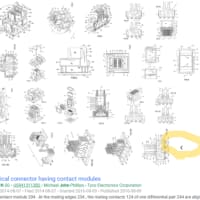WO2005069081
"4. The polarization-modulating optical element according to one of the claims 1 to 3, wherein the polarization- modulating optical element transforms an entering light bundle with a first linear polarization distribution into an exiting light bundle with a second linear polarization distribution, and wherein the first linear polarization distribution is different from the second linear polarization distribution. "
4. 前記偏光変調光学素子は、第1の直線偏光分布を有する入射光束を、第2の直線偏光分布を有する出射光束に変換し、前記第1の直線偏光分布は前記第2の直線偏光分布と異なる、請求項1から3までのいずれか1項記載の偏光変調光学素子。
US2015126905
"1. An optical ferrule, comprising:
an upper wall;
a bottom wall on the opposite side as the upper wall;
a pair of side walls that face each other and connect the upper wall and the bottom wall, such that a guide opening is formed on an inside thereof together with the upper wall and the bottom wall;
a guide part that extends forward from the upper wall and the guide opening; and
an optical coupler provided on an upper surface of the upper wall;
the optical coupler having a waveguide aligning part that aligns and holds an optical waveguide, and a light direction converter;
the light direction converter comprising:
an entrance surface that receives incoming light from the optical waveguide that is aligned and arranged by the waveguide aligning part;
a light direction converting surface that receives light from the entrance surface propagated along an incoming axis, and reflects the received light, wherein the reflected light is propagated by the light direction converting surface along a direction converted axis that is different from the incoming axis; and an exit surface that receives light from the light direction converting surface and propagates the received light along an outgoing axis, and transmits the light as outgoing light emitted from the optical ferrule;
the optical ferrule having an integrated structure. "
1. 上壁と、
前記上壁と反対側の底壁と、
前記上壁及び前記底壁と共に内側にガイド開口部を形成するように、互いに向かい合い、かつ前記上壁と前記底壁とを接続する一対の側壁と、
前記上壁及び前記ガイド開口部から前方に延出するガイド部と、
前記上壁の上面上に設けられた光結合器と、を備える光フェルールであって、
前記光結合器は、光導波路を整列させて保持する導波路整列部と、光方向変換器と、を有し、
前記光方向変換器は、
前記導波路整列部によって整列及び配置される前記光導波路からの入射光を受光する入射面と、
入射軸に沿って伝搬された前記入射面からの光を受光し、かつ前記受光した光を反射する光方向変換面であって、前記反射光は、前記光方向変換面によって、前記入射軸と異なる方向変換された軸に沿って伝搬される、光方向変換面と、
前記光方向変換面からの光を受光し、前記受光した光を出射軸に沿って伝搬し、かつ前記光を、前記光フェルールから放射された出射光として伝送する、出射面と、を含み、
前記光フェルールは一体構造を有する、光フェルール。
US2010328561
"7. 7. The stereoscopic projection system of claim 1, further comprising:
a wavelength selective polarization filter located on one of the input light path and intermediate light path.
8. 8. The stereoscopic projection system of claim 1, further comprising a quarter wave plate located on an output light path."
【請求項7】
前記入射光路及び中間光路のどちらか1つに位置する波長選択偏光フィルタを更に備える請求項1に記載の立体視投影システム。
【請求項8】
出射光路に位置する4分の1波長板を更に備える請求項1に記載の立体視投影システム。
US2015185469
"Fig. 2 shows a side view of a lighting system, e.g. a digital projector unit 140, with a light guide 4070 which is adapted for converting incident light 1300 in such a way that the emitted light 1700 is in the yellow and/or orange wavelength range, i.e. roughly in the wavelength range of 560 nm to 600 nm. The light guide 4070 may e.g. be provided as a transparent garnet made of ceramic materials such as Ce-doped (Lu,Gd)3Al50i2, (Y,Gd)3Al50i2or (Y,Tb)3Al50i2. With higher Ce-content and/or higher substitution levels of e.g. Gd and/or Tb in favor of Ce, the spectral distribution of the light emitted by the light guide can be shifted to higher wavelengths. In an embodiment, the light guide 4070 is fully transparent."
図2は、出射光1700が黄色及び/又は橙色の波長範囲内、すなわち、約560nm~600nmの波長範囲内になるよう入射光1300を変換するよう適合される導光体4070を備えた照明システム、例えばデジタルプロジェクタユニット140の側面図を示す。導光体4070は、例えば、Ceドープ(Lu,Gd)3Al5O12、(Y,Gd)3Al5O12、又は(Y,Tb)3Al5O12等のセラミック材料からなる透明なガーネットとして提供され得る。Ce含有量が多い場合、並びに/又は、例えばCeによるGd及び/若しくはTbの置換度が高い場合、導光体の発光のスペクトル分布はより高い波長にシフトし得る。一実施形態では、導光体4070は完全に透明である。
WO2015175123
"[0040] In the example of FIG. 2, the waveguide 116 corresponds to a multi-core waveguide that includes multiple cores (e.g., multiple channels to independently and simultaneously transmit multiple optical signals between device components, such as the electro-optical transceiver devices 102, 122). The multiple cores may include one or more cores configured to receive outgoing optical signals from a device (or "outgoing cores," such as outgoing cores 206). The multiple cores may include one or more cores configured to receive incoming optical signals from the device (or "incoming cores," such as incoming cores 210). "
[0029] 図2の例では、導波路116は、(たとえば、電気光学トランシーバデバイス102、122など、デバイス構成要素間に複数の光信号を別個に、および同時に送信するための複数のチャネルなど)複数のコアを含むマルチコア導波路に対応する。複数のコアは、デバイス(またはたとえば出射コア206などの「出射コア」)から出射光信号を受信するように構成された1つもしくは複数のコアを含み得る。複数のコアは、デバイス(またはたとえば入射コア210などの「入射コア」)から入射光信号を受信するように構成された1つもしくは複数のコアを含み得る。
US2015233703
"[0083] As shown, the amplitude of the pulses in the output electrical signal 1199 is initially lower toward at time t=0 due to the distribution of the input light 1012a (as exhibited by intensity profile 1000, which has a lower intensity toward the edges 1026a, 1026b of the spatial filter 1026. The amplitude of the pulses increases for a time period due to the increase in the intensity of the input light 1012a (as illustrated by intensity profile 1000) before falling in region 1180 due to the decreased mask feature length of the more light-transmissive regions 1070a (FIG. 6A) in the center region of the spatial filter 1026 which corresponds to region 1180 of the electrical signal 1199. Due to the symmetry of the input light 1012a and the mask pattern 1074a and 1074b around the mask center, the electrical output signal is also roughly symmetric around the mask center. The amplitude of the output electrical signal 1199 initially increases in the time period after the region 1180 due to the gradual increase in the mask feature length of the more light-transmissive regions 1070a (FIG. 6). After increasing for a time period, the amplitude of the output electrical signal 1199 eventually decreases and finally becomes zero due to a decrease in intensity of light as shown by intensity profile 1000. The dual portion mask shown in FIG. 10 is particularly useful to increase signal to noise ratio (SNR) in the signal when a light source having a Gaussian distribution is used because the mask features are largest where the intensity of light is smallest and the mask features are smallest where the intensity of light is greatest. "
[0060] 示されるように、出力電気信号1199におけるパルスの振幅は、(強度プロファイル1000によって示されるように)空間フィルタ1026の端縁1026a、1026bに向かって低い強度を有する入射光1012aの分布に起因して時刻t=0において最初に低くなる。パルスの振幅は、電気信号1199の領域1180に対応する空間フィルタ1026の中央領域におけるより高い光透過性領域1070a(図6A)の減少したマスク特徴の長さに起因して領域1180に落ちる前に(強度プロファイル1000によって図示されるように)入射光1012aの強度の増加に起因して期間について増加する。入射光1012a並びにマスク中央まわりのマスクパターン1074a及び1074bの対称性に起因して、電気出力信号はまた、マスク中央まわりでほぼ対称である。出力電気信号1199の振幅は、より高い光透過性領域1070a(図6)のマスク特徴の長さが徐々に増加するのに起因して、領域1180の後の期間において最初に増加する。期間についての増加後に、出力電気信号1199の振幅は、最終的に減少し、強度プロファイル1000によって示されるような光の強度の減少に起因して最後にゼロになる。図10に示されるデュアル部分マスクは、光の強度が最小である場合にマスク特徴が最大であり且つ光の強度が最大である場合にマスク特徴が最小であることから、ガウシアン分布を有する光源が使用されるとき、信号における信号対雑音比(SNR)を増加させるために特に有用である。
"[0040] In some cases, the light source 112 may comprise a conventional light emitting diode (LED) source or a resonant cavity LED (RC-LED) source. If desired, the light source may incorporate one or more filters to narrow or otherwise tailor the spectrum of the resultant output light. Whichever type of light source is selected, the spectral makeup or composition of the excitation light emitted by the source 112 is preferably tailored to excite, scatter, or otherwise cause emanation of light from at least some of the objects that may be present in the sample, as discussed further below."
[0017] いくつかの場合において、光源112は、従来の発光ダイオード(LED)光源又は共振空洞LED(RC−LED)光源を含むことができる。必要に応じて、光源は、結果の出射光のスペクトルを狭くするか又は調整するための1つ以上のフィルタを組み込むことができる。どんな種類の光源でも選択され、光源112によって照射された励起光のスペクトル構成又は要素は、好ましくは、以下にさらに説明されるように、励起、散乱、又は、試料中に存在することができる物体の少なくとも一部からの光の放射を引き起こすように調整される。
US2010315833
"[0176] Wide angle light beam 36 is output from coupling optic 14, in this example a rectangular etendue-preserving angle-transforming (RAT) reflector with an etendue-preserving angular distribution in each of its two orthogonal output meridians (XY and ZY) that's chosen to maximize the efficiency of input coupling to input face 16 of transparent light guiding bar 18 while also maximizing the spatial uniformity of output brightness produced along the length of the bar's output edge (or face) 8. The light guiding bar's resulting far-field output beam 38 (shown symbolically as a pyramidal solid) is well collimated in the horizontal XY meridian by action of the present invention, and as such achieves a reduced angular width 40 (also referred to as a reduced angular extent), designated as +/−θY (2 θY full angle). Angular distribution of output light 38 in the orthogonal ZX meridian is substantially unchanged by its passage through light guiding bar 18 and retains the original wide angle input beam 36 characteristic of coupling optic 14 in its vertical ZY meridian, in this case a RAT reflector. Angular cone 42 in this vertical ZX meridian is arranged to achieve the most efficient optical coupling of light passing from output edge 8 and into input edge 25 of corresponding light guiding plate 9. Input angle 42 is also chosen to achieve the highest spatial uniformity of the output light extracted across the component's full output aperture surface 11, as will be explained in more detail further below. As input light cone 38 enters through the input edge 25 of light distributing optic 9, it undergoes total internal reflection within plate 28. The angular width of light flowing in the plate's horizontal XY plane is represented symbolically by internal beam cross-section 43, and retains the angular extent 40 of the incoming light in this meridian. The angular relationship between this horizontal light in the air surrounding light distributing optic 9 and the corresponding light within in the medium of plate 28 is simply Sin(θY)=n Sin(θYY) with n being the refractive index of transparent light guiding plate 28. "
[0043] 広角光ビーム36は、結合光学部品14、この実施例では、長方形のエタンデュ保存角度変更(RAT)リフレクタから出力され、2本の直交する出力経線(XYおよびZY)のそれぞれにおけるエタンデュ保存角度分布は、透過性の光ガイドバー18の入力面16に結合する入力の効率を最大にし、バーの出力エッジ(つまり面)8の長さに沿って生成された出力輝度の空間的均一性も最大にするように選択される。光ガイドバーの得られるファーフィールド出力ビーム38(角錐体で象徴的に示される)は、本発明の作用により水平XY経線においてよくコリメートされ、したがって、+/−θY(最大角度2θY)で示される低減された角度幅40(低減された角度範囲とも呼ばれる)が実現される。直交するZX経線における出力光38の角度分布は、光ガイドバー18を通ることによって実質的には変わらず、垂直ZY経線における結合光学部品14(この場合はRATリフレクタ)の特性である、元来の広角入力ビーム36を保つ。この垂直ZX経線における角錐42は、出力エッジ8から対応する光ガイドプレート9の入力エッジ25へと出射光の最も効率的な光学結合を達成するように構成される。入力角42はまた、以下にさらに詳しく説明されるように、コンポーネントの出力アパーチャ表面11全体にわたって抽出された出力光の最も高い空間的均一性を達成するように選択される。入力光錐38が光分配光学部品9の入力エッジ25を通って入射すると、プレート28内で全内部反射を受ける。そのプレートの水平XY面内に流れる光の角度幅は、内側のビームの断面43で象徴的に表され、この経線における入射光の角度範囲40を保つ。光分配光学部品9を取り囲む空中におけるこの水平の光とプレート28の中間における対応する光との角度関係は、単純に、Sin(θY)=n・Sin(θYY)であり、nは透過性の光ガイドプレート28の屈折率である。
US2007144837
(Ab)
"The invention relates to an apparatus for measuring light and a luminaire comprising the apparatus. The apparatus measures light from a first light emitting device located in a first position and comprises a light transmissive device having at least three surfaces: a first surface, a second surface and a third surface; and a photo sensor. The first surface is arranged for incoming light from the first position, the second surface is arranged for reflecting incident light within the light transmissive device and the third surface is arranged such that outgoing light incides onto the photo sensor."
本発明は、光を測定する装置及び光を測定する装置を有する照明器具に関する。当該装置は、第1位置に配置される第1発光装置からの光を測定し、且つ、第1表面、第2表面及び第3表面の少なくとも3つの表面を有する光透過装置と、光センサと、を備える。第1表面は、第1位置からの入来する光のために構成され、第2表面は、光透過装置内において入射光を反射させるように構成され、第3表面は、出射光が前記光センサへ入射するように構成される。


























※コメント投稿者のブログIDはブログ作成者のみに通知されます